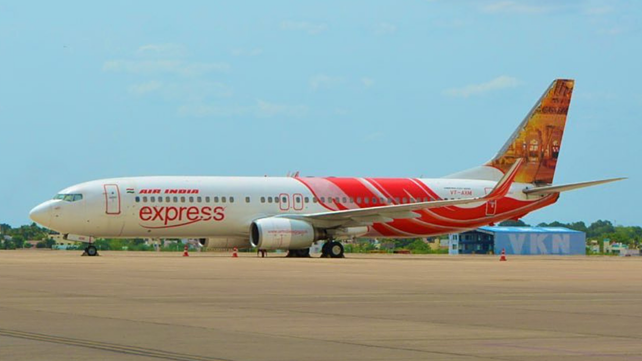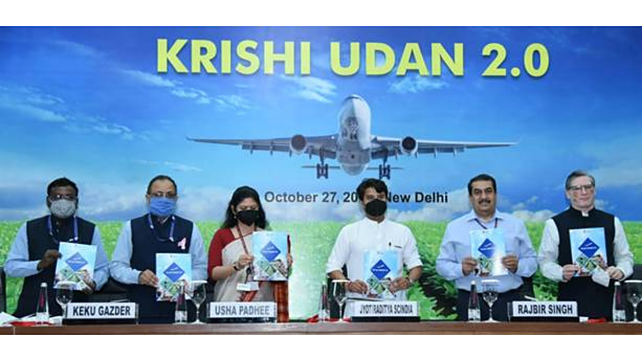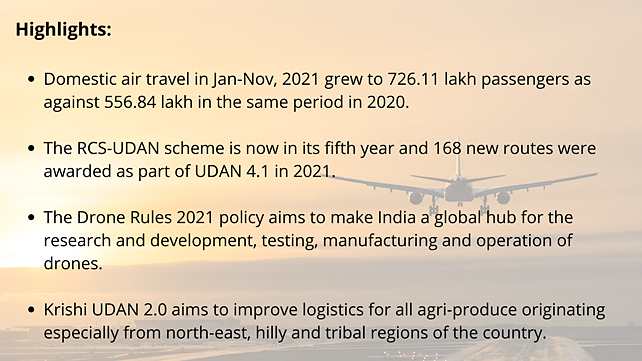
The last two years have seen the Indian aviation sector pass through a turbulent phase due to the ongoing COVID-19 pandemic. However, various new initiatives undertaken by the Indian Government are expected to drive a quick recovery of the aviation sector, once the pandemic is brought under control.
Domestic air travel is already witnessing a revival with the Jan-Nov 2021 period witnessing a healthy recovery, with 726.11 lakh passengers carried as against 556.84 lakh during the corresponding period of the previous year, registering an annual growth of 30.40%.
The RCS-UDAN scheme, which is now in its fifth year, has also helped grow air traffic, and over 100 routes have been introduced with 12 airports operationalised, including three heliports. Under UDAN 4.1, 168 new routes were awarded in 2021.
In addition to the revival of domestic air travel, major decisions taken include the ‘Drone Rules 2021’, which was notified in August 2021, the sale of Air India to the Tata Group and a liberalised FTO policy announced by the Airports Authority of India (AAI) in September 2021 to support growth of aviation industry in the country.
The sale of Air India was concluded by the Government of India with its share purchase agreement inked with Talace in October 2021 for an enterprise value consideration of INR 18,000 crore. Non-core assets of Air India, including its land holdings & buildings, valued at INR 14,718 crore, are to be transferred to Air India Asset Holding Ltd (AIAHL).

In November 2021, the DGCA launched its e-Governance in Directorate General of Civil Aviation (eGCA) initiative with an aim of bringing about ease of doing business, transparency and automation of the processes and functions of DGCA. Services provided to various DGCA stakeholders such as pilots, aircraft maintenance engineers, air traffic controllers, air operators, airport operators, flying training organisations, maintenance and design organisations, etc are now available on eGCA, which offers 300 services.
According to a statement by MoCA, “This single window platform will eliminate operational inefficiencies, minimise personal interaction, improve regulatory reporting, enhance transparency and increase productivity.
Commitment To Drones
An ambitious initiative undertaken by the Government to drive growth of the drone industry in India, the Drone Rules 2021 policy aims to make India a global hub for the research and development, testing, manufacturing and operation of drones. Numerous important steps have already been taken to facilitate the growth of the drone industry in India and these include the approval of a Production Linked Incentive (PLI) scheme in September 2021 for manufacture of for drones and drone components in India.
An incentive of INR 120 crore has been provided for Indian manufacturers of drone and drone components on the basis of their value addition in India, calculated as the annual sales revenue from drones and drone components (net of GST) minus the purchase cost (net of GST) of drone and drone components. The incentive will be spread over three financial years commencing from FY22.
The Unmanned Aircraft System (UAS) Traffic Management (UTM) Policy framework, released in October 2021 will enable complex operations of drones and increase the overall safety in the UTM airspace. As of November 30, 2021, Drone Acknowledgement Numbers (DAN) had been issued to 29,459 drones, of which 888 drones are owned by Government entities.

The Ministry of Civil Aviation’s (MoCA) Digital Sky Platform (DSP) will function as a single window online platform to ensure smooth functionality of the applications and will also regulate to drone operations. The online Digital Sky platform also provides an airspace map of the country, segregated into red, yellow and green zones. Operation of drones in red and yellow zones will be subject to permission from the Central Government and concerned Air Traffic Control authorities respectively.
As of December 15, 2021, six government entities have received permission under Drone Rules, 2021 to perform various drone activities in red and yellow zones. These include Indian Council of Medical Research; National Aerospace Laboratories; Airport Director, Calicut; Indian Institute of Technology Bombay; Tamil Nadu Institute of Urban Studies and the Department of Information Technology, Himachal Pradesh.
Drone operations in green zones will not require any form of approval. This is airspace up to a vertical distance of 400 feet that has not been designated as a red or yellow zone, and the airspace up to a vertical distance of 200 feet above the area located between a lateral distance of 8-12 km from the perimeter of an operational airport. Most of the drone operations will take place in the green zone.
Krishi UDAN 2.0
MoCA’s Krishi UDAN 2.0 initiative aims to improve logistics for all agri-produce originating especially from the north-east, hilly and tribal regions of the country. Seven focus routes have already been identified to support transport of region-specific products such as fruits like Lichi from Darbhanga and pineapple from Agartala, etc.

Primarily, the scheme is to focus on 25 such airports in the north-eastern and other hilly regions – Agartala, Agatti, Barapani, Dehradun, Dibrugarh, Dimapur, Gaggai, Imphal, Jammu, Jorhat, Kullu (Bhuntar), Leh, Lengpui, Lilabari, Pakyong, Pantnagar, Pithoragarh, Port Blair, Raipur, Ranchi, Rupsi, Shimla, Silchar, Srinagar and Tezu.
Twenty eight AAI airports, namely, Adampur (Jalandhar), Agra, Amritsar, Bagdogra, Bareilly, Bhuj, Chandigarh, Coimbatore, Goa, Gorakhpur, Hindon, Indore, Jaisalmer, Jamnagar, Jodhpur, Kanpur (Chakeri), Kolkata, Nasik, Pathankot, Patna, Prayagraj, Pune, Rajkot, Tezpur, Trichy, Trivandrum, Varanasi and Visakhapatnam have also been included in the Scheme.

Under the scheme, the MoCA will offer full waiver of Landing, Parking, TNLC, and RNFC charges for Indian freighter aircraft operating to these regions. Half of Air Freight and TSP charges for cargo terminal operators have also been proposed.
MoCA is coordinating with the Ministry of Agriculture & Farmers Welfare, Department of Fisheries, Department of Animal Husbandry and Dairying, Ministry of Food Processing Industries, Ministry of Tribal Affairs, and Ministry of DONER for implementation of this scheme, though budgets are yet to be sanctioned.